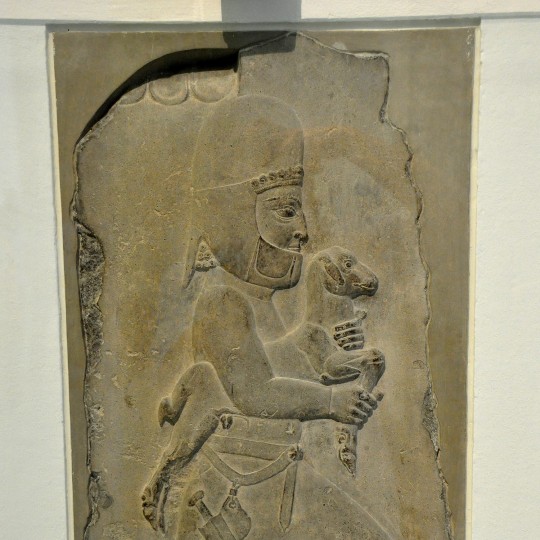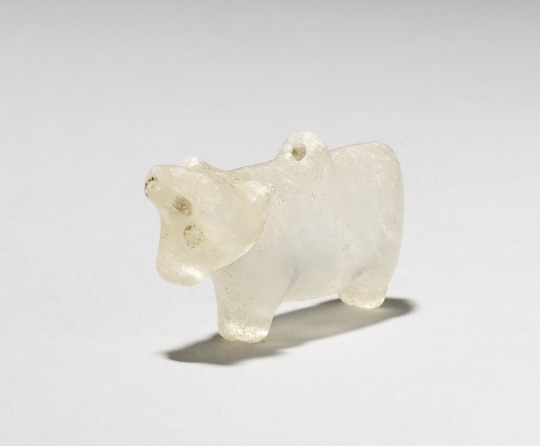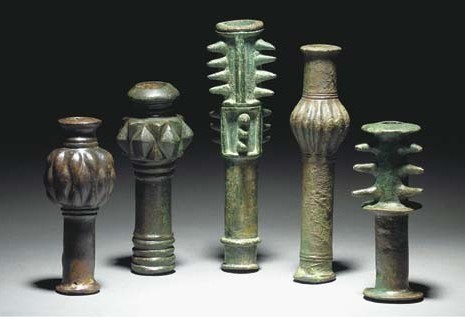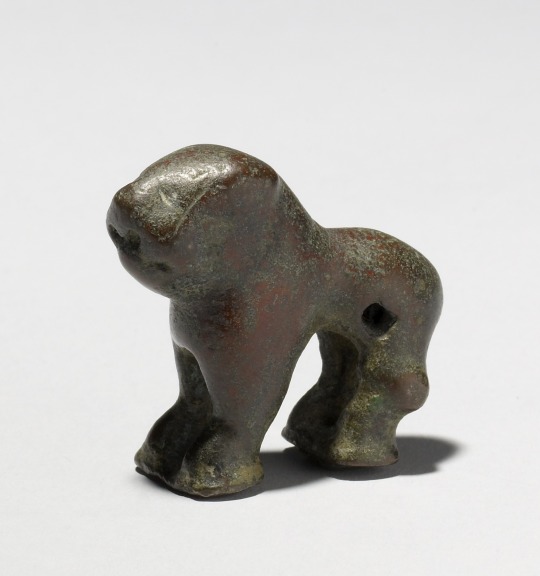#2nd millennium bce
Photo

Medes
The Medes or Medians were a group of Indo-Iranian-speaking people from central Asia who migrated westwards and entered northern Iran around the end of the 2nd millennium BCE. They settled in the highlands of Zagros (Zagreus in Greek) and, by the end of the 7th century BCE, founded the kingdom of Media (Mada in Old Persian).
Continue reading...
161 notes
·
View notes
Text

Bull Figurine or Amulet
Anatolian, 2nd millennium BCE
This protective amulet would have been worn around the neck.
59 notes
·
View notes
Photo

Stamp seal: hunters and goats, rectangular pen (?). ca. early 2nd millennium BCE. Credit line: Gift of Martin and Sarah Cherkasky, 1987 https://www.metmuseum.org/art/collection/search/327300
#aesthetic#art#abstract art#art museum#art history#The Metropolitan Museum of Art#museum#museum photography#museum aesthetic#dark academia
41 notes
·
View notes
Text
*in as faithful a translation as possible if translated at all, especially from a dead language you don't speak (e.g. not anne carson's sappho or a modern adaptation of the epic of gilgamesh)
*provided this is an odd way of grouping together date ranges that is partly eurocentric and partly just plain nonsensical since 12 options are the most one can add
75 notes
·
View notes
Text
For #MetalMonday, two pieces from the Georgian National Museum archaeology collection:

1. Bronze Bear Figure – Pendant
end of 3rd millennium BCE
Abkhazeti, Azanta

2. Gold Lion figurine
2nd half 3rd millennium BCE
Kakheti, Tsnori
#animals in art#ancient art#metalwork#gold#bronze#sculpture#figure#figurine#pendant#effigy#lion#bear#Georgian art#Georgian National Museum#Metal Monday
26 notes
·
View notes
Photo

Semitic Languages
The Semitic languages are a branch of the Afroasiatic language family. They are spoken by more than 330 million people across much of West Asia, the Horn of Africa, and latterly North Africa, Malta, West Africa, and in large immigrant and expatriate communities in North America, Europe, and Australasia. The terminology was first used in the 1780s by members of the Göttingen school of history, who derived the name from Shem, one of the three sons of Noah in the Book of Genesis.
Semitic languages occur in written form from a very early historical date in West Asia, with East Semitic Akkadian and Eblaite texts (written in a script adapted from Sumerian cuneiform) appearing from the 30th century BCE and the 25th century BCE in Mesopotamia and the north eastern Levant respectively. The only earlier attested languages are Sumerian, Elamite (2800 BCE to 550 BCE), both language isolates, and Egyptian (a sister branch of the Afroasiatic family, related to the Semitic languages but not part of them). Amorite appeared in Mesopotamia and the northern Levant circa 2000 BC, followed by the mutually intelligible Canaanite languages (including Hebrew, Phoenician, Moabite, Edomite and Ammonite, and perhaps Ekronite, Amalekite and Sutean), the still spoken Aramaic, and Ugaritic during the 2nd millennium BC.
358 notes
·
View notes
Photo

Mace Heads - bronze - Luristan (now Western Iran) - Late Bronze or Early Iron Age - c.2nd - Early 1st Millennium BCE
77 notes
·
View notes
Text
So who is Baal?
Baal or Baʻal, was a title and honorific meaning 'owner', 'lord' in the Northwest Semitic languages spoken in the Levant during antiquity.
Baal is a God of fertility, weather, rain, wind, lightning, seasons, war, sailors and so on.
Baal worship is also called Baalism.

Solid cast bronze of a votive figurine representing the god Baal discovered at Tel Megiddo, dating to the mid-2nd millennium BC.
His holy symbols are bull, ram and thunderbolt.
Baal was worshipped in ancient Syria, especially Halab, near, around and at Ugarit, Canaan, North Africa and Middle Kingdom of Egypt.
Baʿal is well-attested in surviving inscriptions and was popular in theophoric names throughout the Levant but he is usually mentioned along with other gods, "his own field of action being seldom defined". Nonetheless, Ugaritic records show him as a weather god, with particular power over lightning, wind, rain, and fertility. The dry summers of the area were explained as Baʿal's time in the underworld and his return in autumn was said to cause the storms which revived the land. Thus, the worship of Baʿal in Canaan—where he eventually supplanted El as the leader of the gods and patron of kingship—was connected to the regions' dependence on rainfall for its agriculture, unlike Egypt and Mesopotamia, which focused on irrigation from their major rivers. Anxiety about the availability of water for crops and trees increased the importance of his cult, which focused attention on his role as a rain god. He was also called upon during battle, showing that he was thought to intervene actively in the world of man, unlike the more aloof El. The Lebanese city of Baalbeck was named after Baal.
The Baʿal of Ugarit was the epithet of Hadad but as the time passed, the epithet became the god's name while Hadad became the epithet. Baʿal was usually said to be the son of Dagan, but appears as one of the sons of El in Ugaritic sources. Both Baʿal and El were associated with the bull in Ugaritic texts, as it symbolized both strength and fertility. He held special enmity against snakes, both on their own and as representatives of Yammu (lit. "Sea"), the Canaanite sea god and river god. He fought the Tannin (Tunnanu), the "Twisted Serpent" (Bṭn ʿqltn), "Lotan the Fugitive Serpent" (Ltn Bṭn Brḥ, the biblical Leviathan), and the "Mighty One with Seven Heads" (Šlyṭ D.šbʿt Rašm). Baʿal's conflict with Yammu is now generally regarded as the prototype of the vision recorded in the 7th chapter of the biblicalBook of Daniel. As vanquisher of the sea, Baʿal was regarded by the Canaanites and Phoenicians as the patron of sailors and sea-going merchants. As vanquisher of Mot, the Canaanite death god, he was known as Baʿal Rāpiʾuma (Bʿl Rpu) and regarded as the leader of the Rephaim (Rpum), the ancestral spirits, particularly those of ruling dynasties.
From Canaan, worship of Baʿal spread to Egypt by the Middle Kingdom and throughout the Mediterranean following the waves of Phoenician colonization in the early 1st millennium BCE. He was described with diverse epithets and, before Ugarit was rediscovered, it was supposed that these referred to distinct local gods. However, as explained by Day, the texts at Ugarit revealed that they were considered "local manifestations of this particular deity, analogous to the local manifestations of the Virgin Mary in the Roman Catholic Church". In those inscriptions, he is frequently described as "Victorious Baʿal" (Aliyn or ẢlỈyn Baʿal), "Mightiest one" (Aliy or ʿAly) or "Mightiest of the Heroes" (Aliy Qrdm), "The Powerful One" (Dmrn), and in his role as patron of the city "Baʿal of Ugarit" (Baʿal Ugarit). As Baʿal Zaphon (Baʿal Ṣapunu), he was particularly associated with his palace atop Jebel Aqra (the ancient Mount Ṣapānu and classical Mons Casius). He is also mentioned as "Winged Baʿal" (Bʿl Knp) and "Baʿal of the Arrows" (Bʿl Ḥẓ). Phoenician and Aramaic inscriptions describe "Baʿal of the Mace" (Bʿl Krntryš), "Baʿal of the Lebanon" (Bʿl Lbnn), "Baʿal of Sidon" (Bʿl Ṣdn), Bʿl Ṣmd, "Baʿal of the Heavens" (Baʿal Shamem or Shamayin), Baʿal ʾAddir (Bʿl ʾdr), Baʿal Hammon (Baʿal Ḥamon), Bʿl Mgnm.
The epithet Hammon is obscure. Most often, it is connected with the NW Semitic ḥammān ("brazier") and associated with a role as a sun god. Renan and Gibson linked it to Hammon (modern Umm el-‘Amed between Tyre in Lebanon and Acre in Israel) and Cross and Lipiński to Haman or Khamōn, the classical Mount Amanus and modern Nur Mountains, which separate northern Syria from southeastern Cilicia.
The major source of our direct knowledge of this Canaanite deity comes from the Ras Shamra tablets, discovered in northern Syria in 1958, which record fragments of a mythological story known to scholars as the Baal Cycle. Here, he earns his position as the champion and ruler of the gods. The fragmentary text seems to indicate a feud between him and his father El as background. El chooses the fearsome sea god Yam to reign as king of the gods. Yam rules harshly, and the other deities cry out to Ashera, called Lady of the Sea, to aid. Ashera offers herself as a sacrifice if Yam will ease his grip on her children. He agrees, but Baal opposes such a scheme and boldly declares he will defeat Yam even though El declares that he must subject himself to Yam.
With the aid of magical weapons given to him by the divine craftsman Kothar-wa-Khasis, Baal defeats Yam and is declared victorious. He then builds a house on Mount Saphon, today known as Jebel al-Aqra. (This mountain, 1780 meters high, stands only 15 km north of the site of Ugarit, clearly visible from the city itself.)
Lo, also it is the time of His rain.
Baal sets the season,
And gives forth His voice from the clouds.
He flashes lightning to the earth.
As a house of cedars let Him complete it,
Or a house of bricks let Him erect it!
Let it be told to Aliyan Baal:
'The mountains will bring Thee much silver.
The hills, the choicest of gold;
The mines will bring Thee precious stones,
And build a house of silver and gold.
A house of lapis gems!'
However, the god of the underworld, Mot, soon lures Baal to his death, spelling ruin for the land. His sister Anat retrieves his body and begs Mot to revive him. When her pleas are rebuffed, Anat assaults Mot, ripping him to pieces and scattering his remains like fertilizer over the fields.
El, in the meantime, has had a dream in which fertility returned to the land, suggesting that Baal was not indeed dead. Eventually he is restored. However, Mot too has revived and mounts a new attack against him.
They shake each other like Gemar-beasts,
Mavet [Mot] is strong, Baal is strong.
They gore each other like buffaloes,
Mavet is strong, Baal is strong.
They bite like serpents,
Mavet is strong, Baal is strong.
They kick like racing beasts,
Mavet is down. Baal is down.
After this titanic battle, neither side has completely prevailed. Knowing that the other gods now support Baal and fearing El's wrath, Mot finally bows before him, leaving him in possession of the land and the undisputed regent of the gods.
Baal is thus the archetypal fertility deity. His death signals drought and his resurrection, and brings both rain and new life. He is also the vanquisher of death. His role as a maker of rain would be particularly important in the relatively arid area of Palestine, where no mighty river such as the Euphrates or the Nile existed.
#baal#baal deity#baalism#canaanite gods#canaan#ancient history#ancient gods#history#ancient god#spiritual#deity#deities#religious#religion#religia#ancient religion#ancient world#gods#myth#mythos#ancient myths#mythology#mythology and folklore#myths#Canaanite religion#world religions#world history#ancient mythology
11 notes
·
View notes
Text
Astrology is a range of divinatory practices, recognized as pseudoscientific since the 18th century,[1] that claim to discern information about human affairs and terrestrial events by studying the apparent positions of celestial objects. Different cultures have employed forms of astrology since at least the 2nd millennium BCE, these practices having originated in calendrical systems used to predict seasonal shifts and to interpret celestial cycles as signs of not all, cultures have attached importance to what they observed in the sky, and some—such as the Hindus, Chinese, and the Maya—developed elaborate systems for predicting terrestrial events from celestial observations. Western astrology, one of the oldest astrological systems still in use, can trace its roots to 19th–17th century BCE Mesopotamia, from where it spread to Ancient Greece, Rome, the Islamic world, and eventually Central and Western Europe. Contemporary Western astrology is often associated with systems of horoscopes that purport to explain aspects of a person's personality and predict significant events in their lives based on the positions of celestial objects; the majority of professional astrologers rely on such systems.
Throughout most of its history, astrology was considered a scholarly tradition and was common in academic circles, often in close relation with astronomy, alchemy, meteorology, It was present in political circles and is mentioned in various works of literature, from and to William Shakespeare, Lope de Vega, and Calderón de la Barca. During the Enlightenment, however, astrology lost its status as an area of legitimate scholarly pursuit Following the end of the 19th century and the wide-scale adoption of the scientific method, researchers have successfully challenged astrology on both : 249and experimental grounds, and have shown it to have no scientific validity or explanatory power. Astrology thus lost its academic and theoretical standing in the western world, and common belief in it largely declined, until a continuing resurgence starting in the 1960s. In India, belief in astrology is long-standing, widespread and continuing.
#astrology#astrologer#vastu#vastutips#vastushastra#married life#business problem#career problem#sprituality
9 notes
·
View notes
Text


Bactrian 'Princess', Late 3rd - early 2nd millennium BCE, Oxus civilisation,
Central Asia, Bactria-Margiana. Chlorite and calcite.
Courtesy Alain Truong
34 notes
·
View notes
Photo

Terracotta plaque depicting a ruler from the Old Babylonian period. The Mesopotamian clay plaque dates back to the 2nd millennium BCE. Dallas Museum of Art, Dallas, TX.
Photo by Babylon Chronicle
176 notes
·
View notes
Photo

Historical Fiction of Mesopotamia
Historical fiction is frequently dated to works including the Iliad of Homer (8th century BCE) or The Tale of Genji (11th century CE) or, in English, to the 19th century, usually to the works of Sir Walter Scott, but the genre has more ancient origins dating back to the 2nd millennium BCE through Mesopotamian naru literature.
Continue reading...
143 notes
·
View notes
Text

Lion Figurine
Mediterranean, late 2nd millennium BCE (Cycladic)
Images of lions were popular in the whole Mediterranean and Near Eastern world and related to power, kingship and royalty. Such figurines were believed to serve as protective amulets. This one was made using the lost-wax casting technique.
27 notes
·
View notes
Photo

Spiral bead. ca. late 3rd–early 2nd millennium BCE. Credit line: Purchase, H. Dunscombe Colt Gift, 1969 https://www.metmuseum.org/art/collection/search/325961
#aesthetic#art#abstract art#art museum#art history#The Metropolitan Museum of Art#museum#museum photography#museum aesthetic#dark academia
21 notes
·
View notes
Text
Planetary joys made simple 🌌
Before we get to the bulk of the topic, it’s always important to state that houses are not inherently or “naturally” ruled by any sign in traditional astrology. The 12 letter alphabet (also known as the ABC house system) is a modern concept that does not find its roots in the tradition and while occasional commonalities can be encountered, houses and signs fundamentally exist separately and to conflate them is to misconceive them as they are distinct structures that deserve to be properly understood separately. An analogy I like is one where you see signs as crayons or brushes, planets as artists, and houses as a canvas. Or, think of signs as costumes, planets as actors, and houses as the stage where a play takes place.
Now back to topic. The concept of planetary joys finds its origins in Hellenistic astrology dating back all the way to the 2nd millennium BCE. This concept utilizes the whole sign house system, and entails that planets may have given some of their signifiers to certain houses. This doesn’t translate to houses being inherently connected to said planets, it simply entails that certain house significations were derived from certain planets, and that a given planet is most comfortable in a given house. It also denotes similarity — and gives us a clear idea as to which house is most like which planet.
Starting from the 1H, we can list:
Mercury — rejoices in the first house.
Moon — rejoices in the third house.
Venus — rejoices in the fifth house.
Mars — rejoices in the sixth house.
Sun — rejoices in the ninth house.
Jupiter — rejoices in the eleventh house.
Saturn — rejoices in the twelfth house.
Mercury is a somewhat neutral planet, and in a similar fashion, the 1st house has no clear diurnal/nocturnal status, though it is granted a slightly diurnal status owing to it coinciding with the time where night turns into day. Consequently, Mercury rejoices in the 1st Place, known as the Helm. It may not seem intuitive at first glance, but there is a logic to it as our mercurial functions grow alongside us, and everything we encounter in life is information processed by our brains and bodies. This is the “you” house, the ascendant, a place of being, inception, free will, incarnation, verbalization, & selfhood.
The Moon is purely nocturnal, and neither benefic or malefic, not unlike the 3rd house, where the Sun changes direction as far as the night goes — so the moon rejoicing in what is traditionally known as the house of “Goddess” (Θεά) makes ample sense. The 3rd house is associated with your immediate community, your everyday routines, short distance travel, commutes, siblings, story telling, places of worship, writing, school, communal life, etc. What’s more, is that the lunar calendar has for a very long time set the tone as to where given communities were headed within specific time slots. The connection is rather immediate and intuitive, come to think of it.
The connection between Venus & the 5th house is just as glaringly obvious, if not even more so. Venus is the nocturnal benefic. The 5th house, known as “Good Fortune” is, while below the horizon, still setting and aspecting the 1st house. It’s a house of creativity & creation, art in its many forms, pleasure (sexual or otherwise), romance, charity, diplomacy, praise & worship. Under a capitalistic climate, both Venus & the 5th house are overlooked and deemed unimportant in favour of houses that can be made “profitable” such as the 10th house, but what is the point of being if not to enjoy life?
Next up is Mars, the celestial puppy nocturnal malefic. The 6th house is a not so positive house traditionally, as it is in aversion to the 1st place. It’s referred to as the “place of Bad Fortune”. Mars is a known chaos bringer, and this is the house of all sorts of nuisances, but also remedies. Overwhelming workloads, labour, illness, survival, medicine, herbalism, power, force, fighting, health, medical professionals, pets and small animals (notorious survivalists) are 6th house signifiers. While this house does stand for routines, it usually isn’t the kind that make your life more pleasant (those are more up the 3H’s alley) but things you do out of necessity — work, chores, health check ups, etc. Straightforward correlation.
The Sun is diurnal, neither benefic nor malefic. It’s considered all-seeing, omnipresent, and neutral in disposition, though certain texts (which I fully align with) deem it conditionally malefic. The Sun rejoices in the 9th because it's the most diurnal place, and is in a trine aspect with the ascendant. In traditional astrology, the Sun was defined rather differently than it modernly is, and its qualifiers aligned best with the house of “God” (θεός), the 9H, which is the house of purpose, among others. Here is where the “what purpose was I born for? why am I alive? who am I? what do I want to be?” question finds their answers, in that sense, which explains its association with spirituality, astrology, divination, teachers & professors, higher education & academic pursuits, religion, philosophy & world view. (Under the lens that sun is slightly malefic, these correlations can be seen in the more extreme manifestation of the previously stated topics — zealotry/fanaticism, religious extremism, holy wars, chauvinism, hubris & intellectual arrogance). It’s also the house of long distance travel (which, in a historical context, referred primarily to pilgrimage).
Jupiter is the diurnal benefic. The 11th is succedent, located above the horizon and in a sextile aspect to the 1st. The 11th house is known as “αγαθός δαίμων (= good spirit)”. Traditionally speaking, it’s the house of gifts, allyship & alliances, friendship, community in the broader sense, networks, opportunities, fortunate encounters, political parties & factions, and jupiter is a bringer of growth, prosperity, expansion, abundance, luck, and excess. Side note, but out of all the ABC house correlations, the one I found least coherent was the Aquarius = 11th house conflation (all the others share 2nd place though, objectively) as their principles are antipodal at best, but that’s a topic for another day.
And last but not least, Saturn is the diurnal malefic. And alongside the 8H, the 12th house (known as “Κακός δαίμων = bad spirit”) is a diurnal malefic house, as it is in aversion to the 1st. It’s the house that coincides with the time that precedes your birth, while your mother was in labor or undergoing c-section. The thematics this house derives from Saturn are isolation, suffering, psychological health/illness, the subconscious mind, that which is lost and forgotten, hospitals, stillness, large animals & sublimation. Unseen circumstances that harm the native. Alienation, hardships, self-undoing, hidden enemies, malice & misfortune. Do keep in mind however that the 12th house does not exist in a vacuum, and the extent of its influence on each individual hinges upon more than just it being a house where you might have placements. Overall condition, activation, transits, the presence of mitigating factors, natal promise, etc. They all matter.
Concluding observation that I find extremely cute: 6 out of the 7 planetary joys form pairs using the opposition aspect. The malefics oppose each other, the benefics oppose each other and the luminaries oppose each other.
Do you have any rejoicing planets? I’m curious.
13 notes
·
View notes
Text
More for #WorldFrogDay:

Frog weight
Mesopotamia, Old Babylonian period, c.2000–1600BCE
Stone (diorite or andesite)
12.3 x 21.8 cm, 4.7 kg
inscription: "a frog [weighing] 10 minas, a legitimate weight of the god Shamash, belonging to Iddin-Nergal, son of Arkat-ili-damqa."
Metropolitan Museum of Art, New York
With two bonus hematite babies!

Weights in the shape of frogs
Mesopotamia, Iran, or Cyprus, early 2nd millennium BCE
Hematite
1.12 x 1.5 x 2.62 cm & 1.4 × 0.9 × 0.8 cm
Metropolitan Museum of Art, New York [1] [2]
Photographed on display at the Met in NYC.
#frog#frogs#amphibians#Babylonian art#Mesopotamian art#ancient art#weight#weights and measures#sculpture#stone sculpture#hematite#Metropolitan Museum of Art New York#animal holiday#World Frog Day#museum visit#animals in art
80 notes
·
View notes